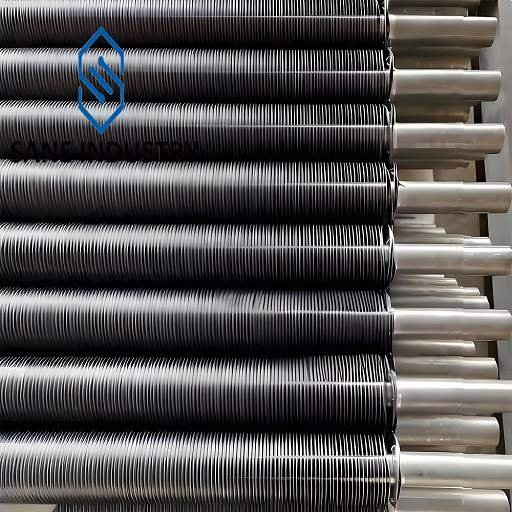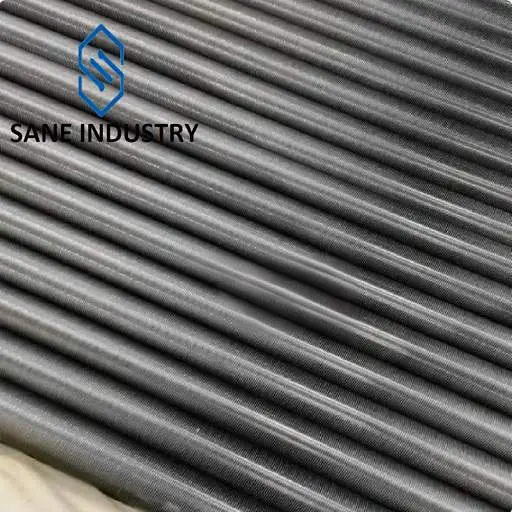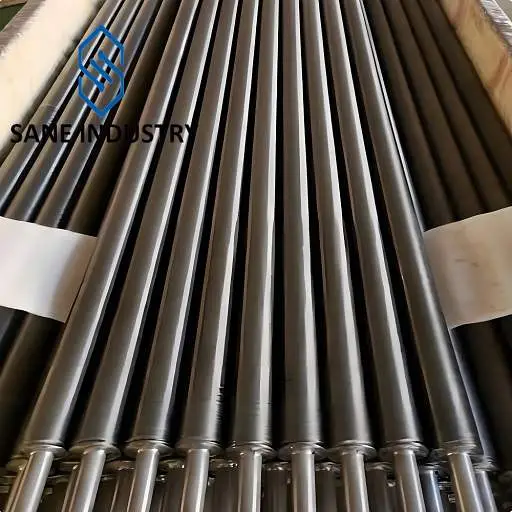What are L Finned Tubes, LL Fin Tubes, KL Fin Tubes
1. L Finned Tubes (L Type Finned Tubes)
- Structure of L Finned Tubes: A continuous strip of metal (e.g., aluminum, copper) is mechanically wrapped around a base tube in a helical pattern. The fin’s “L” shape (like a folded tab) provides a secure grip on the tube.
- Key Features of L Finned Tubes:
- Moderate surface area enhancement.
- Good mechanical strength and durability.
- Cost-effective for standard applications.
- Applications of L Finned Tubes:
- Boilers, air coolers, and HVAC systems.
- Medium-temperature environments (e.g., oil refineries).
2. LL Fin Tubes (LL Type Fin Tubes)
- Structure of LL Fin Tubes: Similar to L-type but uses double-layered fins (two overlapping “L” strips) to create a denser, more tightly packed fin arrangement.
- Key Features of LL Fin Tubes:
- Higher heat transfer efficiency due to increased fin density.
- Reduced risk of fin loosening under thermal cycling.
- Applications of LL Fin Tubes:
- Condensers and evaporators.
- High-moisture or corrosive environments (e.g., chemical processing).
3. KL Fin Tubes (KL Type Fin Tubes)
- Structure of KL Fin Tubes : The base tube surface is knurled (textured) before the L-shaped fin is wrapped around it. The knurling creates grooves that lock the fin in place.
- Key Features of KL Fin Tubes:
- Superior fin-to-tube bonding strength.
- Resistant to vibration and thermal expansion/contraction.
- Applications of KL Fin Tubes:
- High-vibration environments (e.g., power plants, compressors).
- Extreme temperature fluctuations (e.g., industrial furnaces).
4. Structural and Design Differences of L Finned Tubes, LL Fin Tubes and KL Fin Tubes
| Type | Fin Design | Bonding Strength | Best For |
|---|---|---|---|
| L Finned Tubes | Single helical strip | Moderate | Standard heat exchangers |
| LL Fin Tubes | Double-layered fins | High | High-efficiency, corrosive environments |
| KL Fin Tubes | Knurled base | Very High | High-vibration, extreme temperatures |
5. Performance Characteristics Comparison of L Finned Tubes, LL Fin Tubes and KL Fin Tubes
- Heat Transfer Efficiency:
- L Finned Tubes: Less efficient in terms of raw heat transfer, excel in condensing applications where their low-profile fins optimize condensate distribution.
- LL Fin Tubes: Generally offer the highest heat transfer efficiency due to their extensive surface area and turbulent flow characteristics.
- KL Fin Tubes: Follow closely the LL Fin Tubes, particularly in applications where the knurled base enhances heat transfer.
- Pressure Drop:
- L Finned Tubes: Typically have the lowest pressure drop among the three types, making them suitable for applications where flow resistance must be minimized.
- LL Fin Tubes: May be more prone to fouling due to their complex flow paths and increased surface area.
- KL Fin Tubes: Follow closely the LL Fin Tubes, exhibit moderate pressure drop.
- Fouling Resistance:
- L Finned Tubes: Generally offer the best fouling resistance due to their relatively smooth surfaces.
- LL Fin Tubes: Generally offer the highest heat transfer efficiency due to their extensive surface area and turbulent flow characteristics.
- KL Fin Tubes: Have moderate fouling resistance.
- Mechanical Strength:
- L Finned Tubes: May be more susceptible to fin detachment under extreme conditions.
- LL Fin Tubes: Offer good mechanical strength from their spiral wound construction.
- KL Fin Tubes: Typically provide the highest mechanical strength due to the knurled base design, which enhances fin adhesion.
The Manufacturing Process of L Finned Tubes, LL Fin Tubes, KL Fin Tubes
Material Preparation
- Base Tube: Typically made of carbon steel (ASTM A179/A192), stainless steel (AISI 304/316), or copper alloys (C12200). Wall thickness ranges from 1.5–4.0 mm, depending on pressure and temperature requirements.
- Fin Material: Aluminum fins (AA1100/AA1060), copper fins, or corrosion-resistant alloy fins (e.g., titanium). Thickness: 0.4–1.2 mm, pre-cut into strips for L-shaped bending.
L-Fin Formation
- Cold Rolling & Bending: Pre-cut metal strips are fed into a forming machine with L-shaped rollers. The strip is bent at 90° to create the “L” profile.
- Edge Trimming: Laser cutting or mechanical shearing removes excess material to achieve clean fin edges.
Fin Attachment to Base Tube
- Hydraulic Expansion:L-fins are positioned around the base tube. A hydraulic mandrel expands the tube radially (pressure: 50–120 MPa), forcing the tube wall into the fin’s L-groove for mechanical interlocking.
Quality Control
- Tensile testing: To verify fin adhesion strength (>120 MPa for high-performance applications)
- Dimension measurement: Ensuring correct fin dimension
- Surface inspection: For defects in the spiral pattern
- Pressure testing: To check for leaks in the fin-to-tube interface
The Advantages of L Finned Tubes, LL Fin Tubes, KL Fin Tubes
Superior Heat Transfer
- L-shaped fins induce turbulence, increasing surface contact by 25–40% vs. smooth tubes, with heat exchange efficiency up to 35% higher.
Robust Bonding Integrity
- Mechanical interlocking (hydraulic expansion) eliminates thermal contact resistance (≤0.01 m²·K/W), ensuring stability under thermal cycling.
Corrosion & Wear Resistance
- Anodized aluminum or epoxy-coated surfaces withstand harsh environments (pH 2–12, salinity ≤5%), extending service life to 15+ years.
Compact & Customizable Design
- Adjustable fin height, pitch, and spiral angles (15°–60°) optimize space utilization for boilers, condensers, and HVAC systems.
Low Maintenance & Energy Savings
- Reduced fouling risk (Ra ≤0.8μm surface) and 20–30% lower pumping power vs. plain tubes, cutting operational costs.
The Disadvantages of L Finned Tubes, LL Fin Tubes, KL Fin Tubes
Higher Manufacturing Costs
- Complex forming increase production costs by 15–25% vs. smooth or helical fin tubes.
- Material waste from trimming L-fin edges (up to 8% material loss).
Limited Flexibility in Design Adjustments
- Fixed fin geometry (L-shape) restricts post-production modifications to fin height/pitch.
- Spiral angle adjustments require retooling, raising lead times by 20–30%.
Corrosion Vulnerabilities in Joints
- Mechanical bonding interfaces (e.g., hydraulic expansion) may trap moisture, accelerating crevice corrosion in chloride-rich environments.
Weight and Space Constraints
- Dense fin arrangements (≥8 fins/cm) add 30–50% weight vs. plain tubes, limiting use in weight-sensitive applications.
- L-fin protrusions require larger clearances in compact heat exchangers.
Fouling and Maintenance Challenges
- Turbulence-enhancing fins trap particulates in high-dust environments, increasing cleaning frequency by 2–3×.
- Narrow fin gaps (<3 mm) complicate mechanical descaling.
Thermal Stress Risks
- Differential expansion between fins and base tubes (e.g., Al/steel pairs) may crack welds under rapid thermal cycling (>200°C/hour).
The Application of L Finned Tubes, LL Fin Tubes, KL Fin Tubes
L Finned Tubes
- Power plants: Used in condensers for efficient steam-to-water conversion
- Chemical processing: Reactor cooling with corrosion-resistant materials
- Refrigeration: Evaporators/condensers with low pressure drop
LL Fin Tubes
- Petrochemical: High-temperature fluid cooling (up to 500°C)
- Power plants: Waste heat recovery in economizers/air preheaters
- Paper industry: Compact drying systems with high thermal conductivity
KL Fin Tubes
- HVAC: Lightweight, vibration-resistant air-cooled condensers
- Food processing: Hygienic spray dryers for powders
- Building heating: Durable radiators for thermal cycling
Sizes and Materials of Our L Finned Tubes, LL Fin Tubes, KL Fin Tubes
| Base Tube Diameter | 19 to 73 mm | 3/8″ to 2.1/2″ NPS |
| Base Tube Wall Thickness | 0.8 to 5 mm | 0.03″ to 0.19″ |
| Base Tube Length | ≤32,000 mm | ≤92 ft |
| Base Tube Material | Carbon Steel (A106B, P235GH, A179, A210, A192, etc.) Alloy Steel (P5, T5, P9, T9, T11, T22, etc.) Stainless Steel (TP304, TP316, TP347, B407 800H/HT, etc.) aluminum, copper, titanium | |
| Fin Pitch | 118 to 472 FPM | 3 to 12 FPI |
| Fin Height | 5 to 20 mm | 0.19″ to 0.79″ |
| Fin Thickness | 0.4 to 1 mm | 0.01″ to 0.04″ |
| Fin Material | aluminum, copper | |
| Fin Type | L, LL, KL-Foot | |
For other customized requirements for L Finned Tubes, LL Fin Tubes, KL Fin Tubes, please contact us.
Our Production Capacity of L Finned Tubes, LL Fin Tubes, KL Fin Tubes
Total six L, LL, KL-Foot fin tube machines, monthly production capacity is 180,000 meters in total.
Comparison with Other Finned Tubes
| Parameter | L Type Fin Tube | Spiral Fin Tube | Longitudinal Fin Tube | Serrated Fin Tube |
|---|---|---|---|---|
| Fin Geometry | L-shaped, 90° vertical-horizontal bend | Helical, continuous spiral wrap | Straight, parallel to tube axis | Serrated edges, discontinuous |
| Heat Transfer Efficiency | High (↑25–35% vs. smooth tubes) | Moderate (↑15–25%) | Low (↑5–15%) | Very High (↑30–45%) |
| Pressure Drop | High (↑15–40%) | Moderate (↑10–20%) | Low (↑5–10%) | Very High (↑30–50%) |
| Manufacturing Cost | High (complex forming/welding) | Low (automated spiral wrapping) | Very Low (simple attachment) | Moderate (precision cutting) |
| Corrosion Resistance | Moderate (joint vulnerabilities) | High (seamless spiral bonding) | Low (edge gaps trap contaminants) | Low (serrations trap moisture) |
| Fouling Resistance | Low (turbulence traps particulates) | Moderate | High (smooth flow paths) | Very Low (serrations trap debris) |
| Space Efficiency | Compact (dense fin arrangement) | Bulky (wide spiral pitch) | Moderate | Compact |
| Thermal Stress Resistance | Moderate (cracking risk at joints) | High (uniform expansion) | Low (linear expansion mismatch) | Low (stress concentration) |
| Best Applications | Petrochemical, high-pressure boilers | HVAC, low-corrosion environments | Low-temperature exchangers | High-dust, aggressive cooling |
Why Choose Us
- a 16-year LL fin tubes supplier. We are experts.
- solutions for all your needs
- the highest product quality
- the low lead times
- excellent customer service








